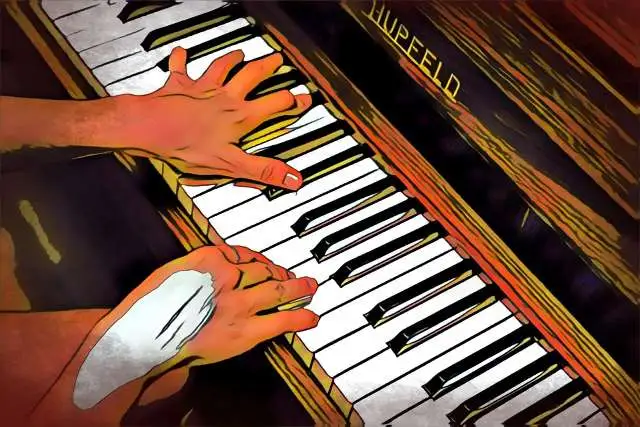Chord progressions are the building blocks of songs. After all, a chord progression serves as a predictable pattern that stands as the foundation that allows other melodies, rhythms, and musical ideas to flourish. However, how does one come up with a chord progression? And what's the theory behind them?
Below, we'll detail everything you need to know about chord progressions and how to build them. We'll also share some tips for creating unique progressions so that your compositions can stand out from the crowd.
What Are Chords and Chord Progressions?
In their simplest form, chords are collections of notes that are sonically pleasing when played together. Chords progressions are patterns of chords that help evoke a certain feeling amongst the listener. There are a handful of common chord progressions you hear in a majority of today's modern music, but once you understand how chords are created, you can go far beyond the most popular chord progressions to expand your sonic vocabulary.
Just like scale degrees, different types of chords are notated with Roman numerals. Chords with uppercase roman numerals signify major chords, while chords with lowercase Roman numerals are minor chords. You'll usually see chord progressions consisting of three or four chords, though these numbers are not absolute. There are plenty of two chord and five chord progressions as well, though they may be less common than three or four chord progressions.
How Chords Are Created
In order to understand how a chord progression works, you have to break down what a chord is first. Essentially, a chord is a collection of pitches or notes. These pitches usually have a strong relationship with one another as established within a particular key.
Chords usually consist of at least three notes. They are named off of the key they are based on. For instance, the C major chord utilizes notes from the key's major scale. In the key of C major, a major scale is C D E F G A B C. We know this from using the universal formula for major scales, which is whole step-whole step-half step-whole step-whole step-whole step-half step (WWHWWWH), as shown below.
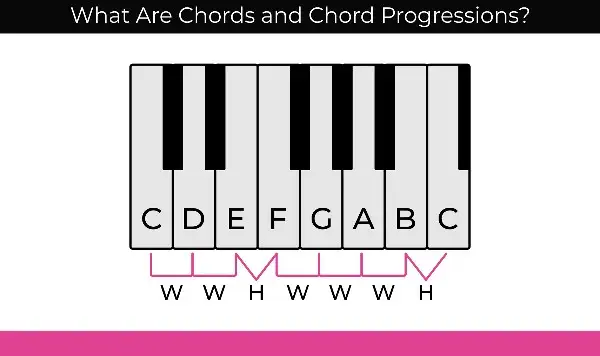
A whole step consists of two semitones or two keys on the piano, while a half step is the distance of one key on the piano or one semitone. Within a scale, there are different types of notes referred to as scale degrees. The scale degrees and relationships between certain notes are consistent regardless of what scale you use. You'll find that the main difference between different scales is the starting note and what type of scale it is (major, minor, pentatonic, diminished, etc.).
For the sake of this example, let's look at the key of C major's scale degrees:
1st: C - Tonic
2nd: D - Supertonic
3rd: E - Mediant
4th: F - Subdominant
5th: G - Dominant
6th: A - Submediant
7th: B - Leading Tone
A major chord consists of the tonic, mediant, and dominant or the 1st, 3rd, and 5th scale degrees. Therefore, in the key of C major, a C Major chord is C-E-G. Chords that consist of three notes are referred to as triads. You can also have chords with additional notes.
For instance, a C Major 7th chord, or Cmaj7, consists of C-E-G-B. Notice how this chord is just like C Major, just with the added 7th scale degree or leading tone, which happens to be B. There are different formulas for various types of chords which we'll detail below.
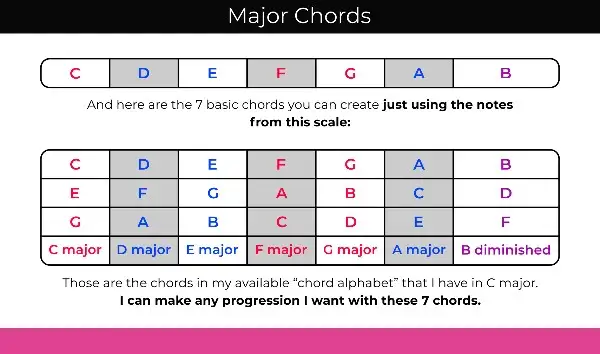
In the graphic above, you can see how different scale degrees can be used to create different chords. Each type of chord has its own formula, so to speak, which we'll go over below.
Major Chords
A major chord is one of the most popular bases for common progressions in Western music. You can create a major triad by adding the third and fifth major scale degrees to the tonic in a major scale. Major triads have a happier ring to them, and help emphasize the root note or tonic of a scale. In G major, a G major chord consists of the notes G, B, and D per the G major scale. Any chord built off of the 1st, 3rd and 5th scale degrees of a major scale is considered a major triad.
Minor Chords
A minor chord is another popular chord that's the root chord of a minor scale. Just like a major chord, a minor triad is made out of the first, third, and fifth scale degrees of the minor scale. Let's take the A minor scale for instance which consists of A, B, C, D, E, F, and G. Using the formula, we can deduce that an A minor chord is made up of A, C, and E.
Diminished Chords
Like other triads, diminished chords are based off of the first, third, and fifth scale degrees. To create a diminished chord, the tonic of a major scale is layered with a flattened third and flattened fifth of the scale. So, to form C diminished, the major chord C, E, G would change to C, E flat, and G flat.
Seventh Chords
If you want to add a little more depth to your chords, you can add the seventh degree to a chord. Seventh chords are formed by taking a triad and adding the leading tone. If we use a C major chord as an example, C, E, G transforms to CMaj7 with the notes C, E, G, B.
Inversions
Inversions refer to chords that consists of the same notes as a typical chord, except the root note is not in the base of the note. Let's take C major for example -- C major is typically notated as C, E, and G with the tonic as the base. So, an inversion of the C major chord could be E G C or G C E.
Tonic, Dominant, and Predominant Chords
Different types of chords can be generalized, just as though scale degrees can be generalized. Understanding how these types of chords function can make it easier for you to create a chord progression that makes a lot of sense. You can categorize chords as tonic, dominant, and predominant chord types:
Tonic
These types of chords have a strong relationship to the tonic of a any scale. Tonic chords are the I, III, and VI chords within a scale.
Dominant
Dominant chords emphasize the 5th and 7th scale degrees. The dominant chords are the V chord and VII chord.
Predominant
Predominant chords or subdominant chords help imply the perfect 4th within a scale. These chords are the IV and II chord.
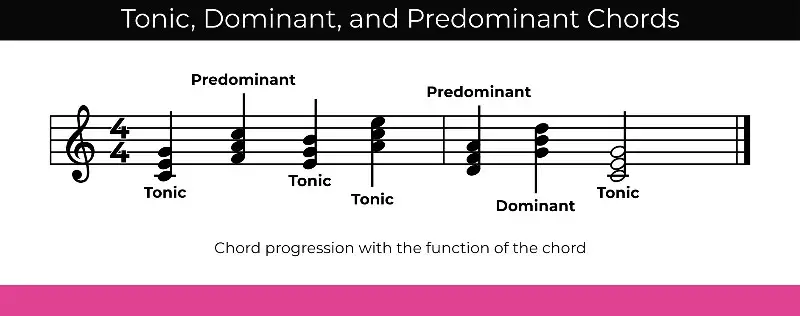
The Different Types of Chord Progressions
There are several different types of chord progressions within the world of music.
Diatonic Chord Progressions
The world diatonic just means using notes within a scale. Therefore, a diatonic chord progression, utilizes only notes contained within a scale. So, a diatonic chord progression utilizing a C Major scale would be something like C-G-Am-F. These are fairly simple chord progressions that are fairly harmonious.
Natural Minor Chord Progressions
These chord progressions only utilize notes within a minor scale. So, a natural minor chord progression utilizing the key of A minor could be something like Am-F-G. It could also be something like Em-G.
Melodic Minor Chord Progressions
Melodic minor chord progressions are built off of the minor scale, but with a raised 6th and raised 7th scale degree. Therefore, these progressions utilize chords within the melodic minor scale. So, a melodic minor chord progression could be something like Cmin-F-G-Cmin.
Harmonic Minor Chord Progressions
Harmonic minor chords are those built off of the harmonic minor scale. This is similar to the natural minor scale, except the harmonic minor scale features a raised 7th. So, a harmonic minor chord progression could be something like Am-F-G#dim.
5 Chord Progressions Every Musician Should Know
You'll find common chord progression examples sprinkled all throughout popular music. These common chord progressions can be used as inspiration to help you develop your own or played as is. Here are a couple of common chord progression tropes you'll need to know as a musician.
I–IV–V–I
This chord progression is seen all throughout rock songs, though it still shows up in pop music today. Just listen to the progression in the hit song, "Despacito":
I–V–vi–IV
This is a popular chord progression that has dominated the charts. Take a look in how it's used in the classic "She Will Be Loved" by Maroon 5:
I–V–iv–I
This is another common chord progression seen in popular songs across a wide span of genres. Take a listen to Toto's "Africa" to hear this chord progression in action:
vi-IV-I-V
This is a classic four chord progression that is sure to please. Hear the chords played in the verse of The Beatles' "Let It Be" to get a taste of its sound:
I-vi-ii-V
This chord progression has been used for centuries. Check out its use in the classic song "Heart and Soul":
How To Write Your Own Chord Progression
Now that you have a couple of common chord progressions to source from, let's dive into how you can write one of your own! Here's a step by step process for creating chord progressions.
1. Pick a Key
Chord progressions work by working within a certain key. To start, decide what key and scale you want to use to create chords. There isn't one right way to interpret how a chord progression feels, but you can generally associate a happier, upbeat tone with a major key and a more somber feel with a minor key.
2. Build Off Your Starting Chord
Once you decide on your starting key, use the tonic chord or beginning chord as your starting chord. Typically a chord progression consist of four chords, but it can consist of five chords or more depending on how fast the chord changes are. You can also jazz up your starting chord by adding 7th or leading notes to the common chord triad for a bit more sonic depth.
3. Use A Progression Reference
There's nothing wrong with using a chord chart reference! This little cheat sheet will show you how to create a diatonic chord progression in all of the keys. You can start to combine different chord degrees together or use one of the common patterns discussed above.
Ref graphic:
4. Add Notes
Don't be afraid to spice up your chord progression by adding more notes. You can easily convert chords into 7th chords by adding an extra scale degree, or inserting notes in between chords to facilitate a smoother transition from one chord to the next.
5. Try It Out
When in doubt, try it out! There aren't any hard and fast rules when it comes to building a chord progression, so feel free to experiment. You might find yourself reverting back to some of the most popular chord progressions out there, and that's okay too. As the saying goes, "If it ain't broke, don't fix it"!
Tips For Creating Interesting Chord Progressions
Now that you know the basics behind common chord progressions check out these tips so that you can speed up your workflow and create more interesting chord progressions.
Using the 4/3 Trick
If you're in a pinch, or don't have your musical scales memorized, don't panic! You can use the 4/3 trick to help you determine any major chord. To do this, select a root note in a scale. In the key of C major, that's C. To find the other two notes in the chord, first go up four semitones. If you're starting on C, that will land you on E. From E, go up three more semitones to find the final note of the triad, G. You can also reverse the trick as 3/4 to determine minor chords using any scale.
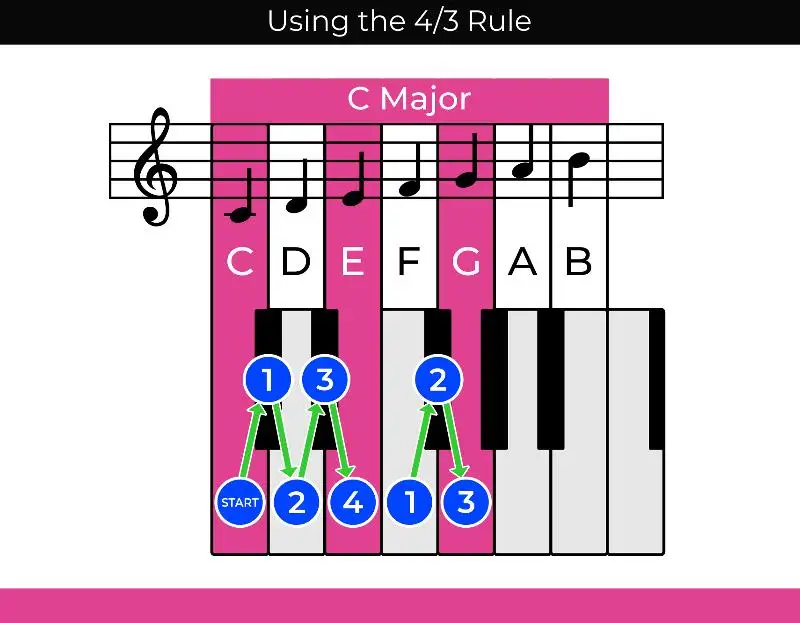
Dominant 7th
One of the most popular chords that are outside the basic minor or major structure is the dominant 7th chord. This chord type is often used to help lead back to tonic or I chord. To create a dominant 7th chord, first create a major 7th chord. Then, lower the 7th note by a single semitone. So for CMaj7 (C, E, G, B), and dominant 7th chord becomes C, E, G, B flat. You'll often see the dominant chord used in genres like blues, rock and jazz.
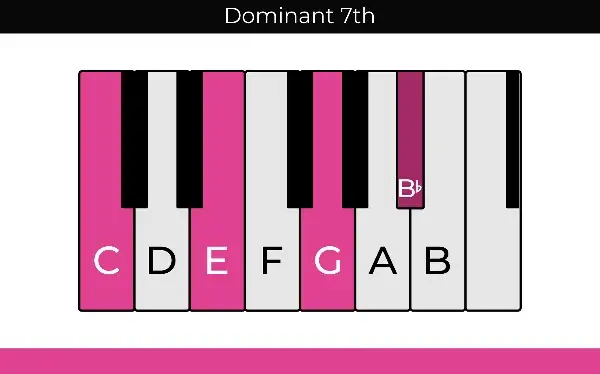
Polychords
If you're looking for a quick way to build different chord progressions, create a polychord. Polychords essentially combines two major or minor chords and create a single chord that's larger than the typical triad. For instance, you could easily combine the chords C Major (C, E, G) and G Major (G, B, D) to create CMaj9 which consists of C, E, G, B, D notes.
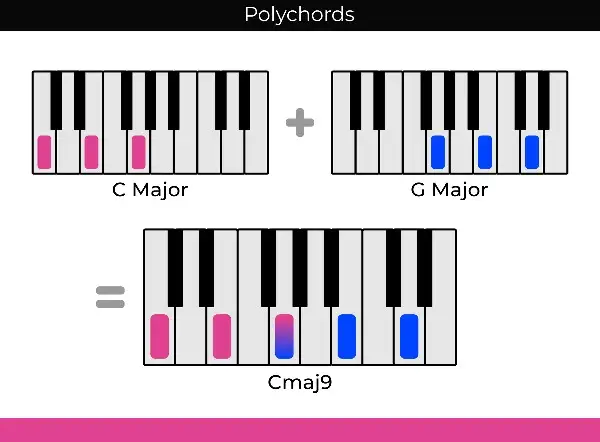
It's important for any musician to understand chord progressions whether you're a producer, songwriter, engineer, or somewhere in between. Hopefully, this guide makes it easier for you to build chord progressions confidently and decode any particular chord progression when you come across it. With just a little bit of music theory, you can decode just about any song.


